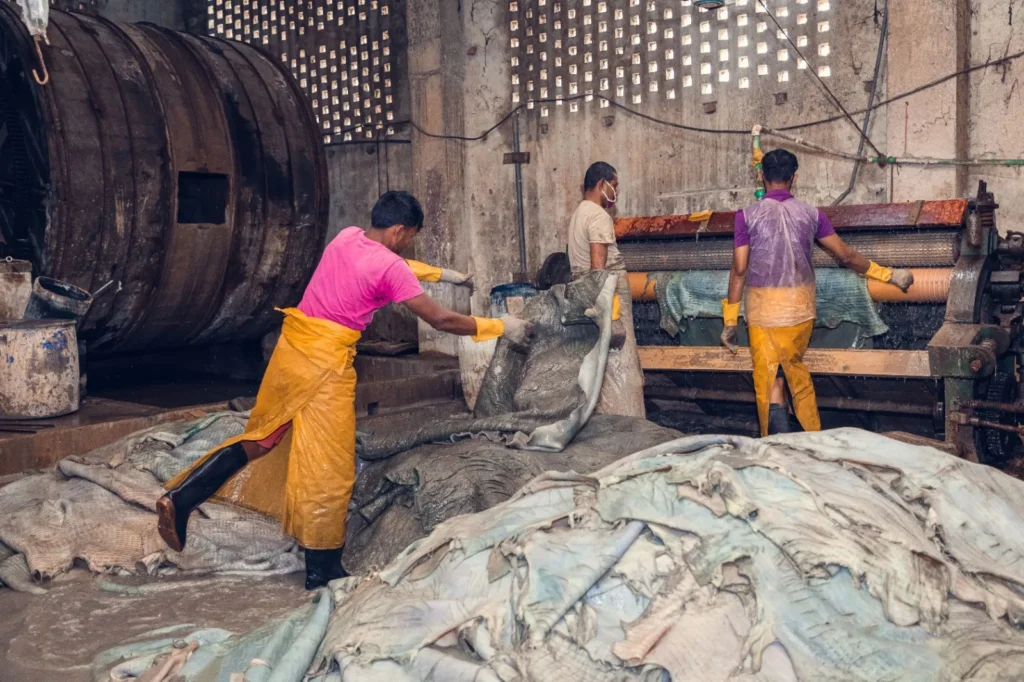Rawhide Crisis in Bangladesh is simple matter in Leather Sector in Bangladesh. Every year, Eid-ul-Azha, the second largest Islamic festival, marks not only a spiritual sacrifice but also a major economic activity in Bangladesh’s leather sector. Millions of cattle, goats, and other livestock are sacrificed nationwide.
1. The Promise of a Leather Legacy: Rawhide Crisis in Bangladesh
Bangladesh’s leather industry has long been considered the “golden goose” of the economy. Known for producing high-quality leather goods at competitive prices, the country once exported leather products worth over $1 billion annually. Local and international demand for Bangladeshi leather helped generate thousands of jobs and contributed significantly to the country’s GDP.
Traditionally, this festival fuels the country’s leather industry by providing an abundant supply of rawhide — the primary material for leather goods. But in recent years, this legacy has been crumbling. Mismanagement, unfair pricing, lack of preservation facilities, and the failure to meet international standards have driven the once-thriving rawhide trade into a downward spiral.
Eid-ul-Azha used to be the peak season for rawhide collection. Nonprofits, madrassas, and seasonal traders collected sacrificial hides for sale to wholesalers and tannery owners. However, what was once a profitable sector has now become plagued by waste, underpricing, and chaos.
2. Declining Rawhide Prices: Rawhide Crisis in Bangladesh
One of the most prominent issues facing the rawhide trade is unfair pricing. In 2024, the government fixed the price of cowhide at Tk 50-55 per square foot in Dhaka, and Tk 45-48 in other regions. Goat skin was priced at Tk 18-20. But in reality, sellers — especially small traders and rural collectors — struggled to get even half of that.
Reports emerged of rawhide being sold at Tk 100 per piece or less — sometimes even given away for free to avoid spoilage. In the worst cases, thousands of hides were dumped in landfills or rivers, left to rot in the streets due to the absence of buyers and poor storage.
3. Preservation Failures: A Seasonal Tragedy Rawhide Crisis in Bangladesh
Preservation is a vital link between collection and processing. But in Bangladesh, inadequate storage and insufficient use of salt — a critical preservative — lead to widespread rawhide spoilage. Most small collectors lack the resources or knowledge to salt the hides properly.
Local storage centers or cold storage facilities are almost nonexistent in rural areas. Even in major cities, logistics constraints delay hide transport to tanneries, allowing bacteria and heat to destroy their usability. Once spoiled, the rawhide becomes worthless, compounding the losses for both collectors and tannery owners.
4. Exploitative Middlemen and Lack of Regulation: Rawhide Crisis in Bangladesh
The rawhide market is largely informal and unregulated. Middlemen dominate the supply chain and often exploit both the sellers and the buyers Rawhide Crisis in Bangladesh. They buy sacrificial hides at throwaway prices during Eid, hoard them briefly, and sell them to tanneries at inflated rates.
This lack of pricing transparency and monitoring has created distrust between farmers, seasonal traders, and tannery owners. It has also deterred charitable organizations and madrassas from participating actively, as they often receive minimal financial return from their collections.
5. The Role of Tanneries: Promise vs. Performance

Bangladesh relocated its tannery industry from Hazaribagh to Savar Tannery Estate with the goal of improving environmental compliance and product quality. But years later, Savar still lacks a fully functional central effluent treatment plant (CETP). As a result, leather produced here often fails to meet global environmental and quality standards.
Due to these issues, many international buyers — especially in the EU and North America — have blacklisted Bangladeshi leather. The country’s once-booming export potential has declined significantly. While the industry could be worth billions, it now struggles to maintain even a basic presence in premium global markets.
6. Government and Industry Response: Too Little, Too Late?
The government has taken steps such as price fixing and tannery relocation, but many experts argue that these are reactive rather than preventive. Without year-round monitoring, infrastructure development, and fair-trade enforcement, temporary solutions will not suffice.
Moreover, financial aid or incentives for small collectors, charitable organizations, or preservation efforts are minimal. The absence of investment in rural rawhide processing facilities is one of the key reasons behind the seasonal waste of millions of hides.
7. A Glimmer of Hope: What Needs to Be Done
Despite the gloom, industry experts and entrepreneurs believe that with the right strategy, the leather industry can still bounce back. Here’s what Bangladesh needs:
- Decentralized preservation centers in rural areas
- Training and awareness campaigns for seasonal collectors on how to properly salt and store hides
- Transparent pricing mechanisms and digital payment systems for fair transactions
- Support for madrassas and NGOs with direct collection channels
- Investment in modern tannery technology and a fully operational CETP in Savar
- Global branding and certification to regain export credibility
If these reforms are implemented effectively, Eid-ul-Azha can once again become a season of economic upliftment instead of waste and despair.
8. Conclusion: Time to Save the Legacy
The leather sector in Bangladesh stands at a crossroads. Once hailed as a national asset, it is now burdened by systemic problems that threaten its future. The annual rawhide collection during Eid-ul-Azha is not just a tradition — it is a massive economic opportunity that must not be lost due to neglect, greed, and inefficiency.
To protect the country’s leather legacy, all stakeholders — government, private sector, religious institutions, and international partners — must work together. Only through sustainable practices, transparent policies, and modern infrastructure can Bangladesh revive its place as a global leather leader.

